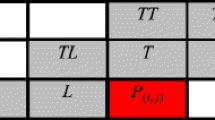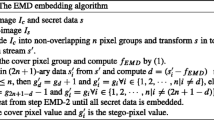Abstract
In this paper, we propose a novel data hiding scheme with reversibility based on exploiting modification direction (EMD). One cover image is first chosen and prepared to generate two visually similar steganographic images. During the secret embedding, the pixels in the first steganographic image are modified by no more than one gray level to embed secret data using the traditional EMD method, while the pixels in the second steganographic image are adaptively modified through referring to the first steganographic image without any confusions in image recovery process. On the receiver side, secret data can be extracted easily and the original cover image can also be recovered from the two steganographic images correctly. Experimental results demonstrate that our scheme can achieve high hiding capacity and satisfactory visual quality.






Similar content being viewed by others
References
Alattar AM (2004) Reversible watermarking using the difference expansion of a generalized integer transform. IEEE Trans Image Process 13(8):1147–1156
Chan CK, Cheng LM (2004) Hiding data in images by simple LSB substitution. Pattern Recogn 37(3):469–474
Coltuc D (2012) Low distortion transform for reversible watermarking. IEEE Trans Image Process 21(1):412–417
Highland HJ (1997) Data encryption: a non-mathematical approach. Comput Secur 16(5):369–386
Ker A (2004) Improved detection of LSB steganography in grayscale images. In: Proc Information Hiding Workshop, vol. 3200. Springer LNCS, pp. 97–115
Lee CF, Chen HL, Tso HK (2010) Embedding capacity raising in reversible data hiding based on prediction of difference expansion. J Syst Softw 83(10):1864–1872
Li XL, Li B, Yang B, Zeng TY (2013) General framework to histogram-shifting-based reversible data hiding. IEEE Trans Image Process 22(6):2181–2191
Mielikainen J (2006) LSB matching revisited. IEEE Signal Proc Lett 13(5):285–287
Ni Z, Shi YQ, Ansari N, Su W (2006) Reversible data hiding. IEEE Trans Circ Syst Video Technol 16(3):354–362
Qin C, Chang CC, Huang YH, Liao LT (2013) An inpainting-assisted reversible steganographic scheme using a histogram shifting mechanism. IEEE Trans Circ Syst Video Technol 23(7):1109–1118
Rivest RL, Shamir A, Adleman L (1978) A method for obtaining digital signatures and public-key cryptosystem. Commun ACM 21(2):120–126
Thodi DM, Rodriguez JJ (2007) Expansion embedding techniques for reversible watermarking. IEEE Trans Image Process 16(3):721–730
Tian J (2003) Reversible data embedding using a difference expansion. IEEE Trans Circ Syst Video Technol 13(8):890–896
Zeng XT, Li Z, Ping LD (2012) Reversible data hiding scheme using reference pixel and multi-layer embedding. AEU Int J Electron Commun 66(7):532–539
Zhang X (2013) Reversible data hiding with optimal value transfer. IEEE Trans Multimed 15(2):316–325
Zhang X, Wang S (2006) Efficient steganographic embedding by exploiting modification direction. IEEE Commun Lett 10(11):781–783
Zhou J, Au OC (2012) Determining the capacity parameters in PEE-based reversible image watermarking. IEEE Signal Proc Lett 19(5):287–290
Acknowledgments
This work was supported by the Natural Science Foundation of China (61303203), the Natural Science Foundation of Shanghai, China (13ZR1428400), and the Innovation Program of Shanghai Municipal Education Commission (14YZ087).
Author information
Authors and Affiliations
Corresponding author
Rights and permissions
About this article
Cite this article
Qin, C., Chang, CC. & Hsu, TJ. Reversible data hiding scheme based on exploiting modification direction with two steganographic images. Multimed Tools Appl 74, 5861–5872 (2015). https://doi.org/10.1007/s11042-014-1894-5
Published:
Issue Date:
DOI: https://doi.org/10.1007/s11042-014-1894-5




